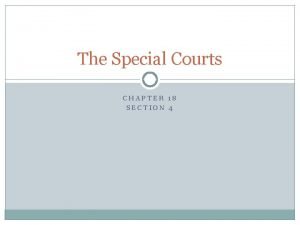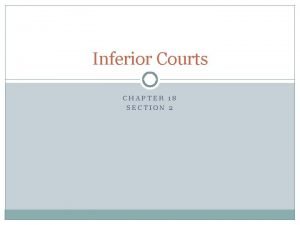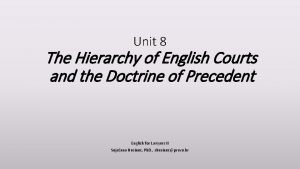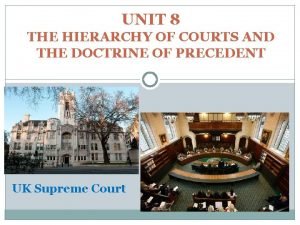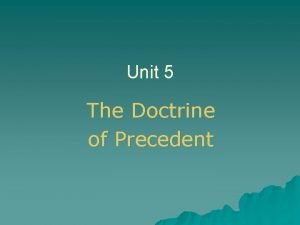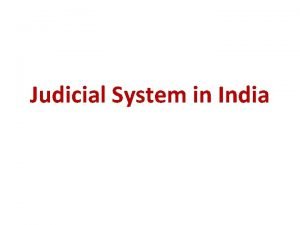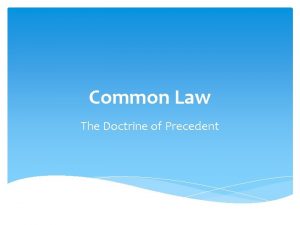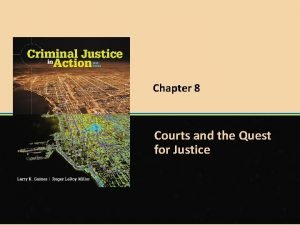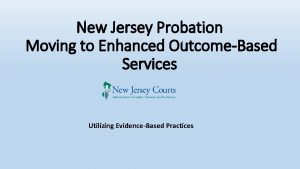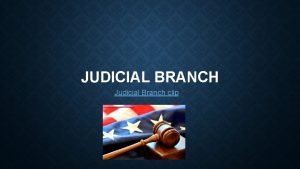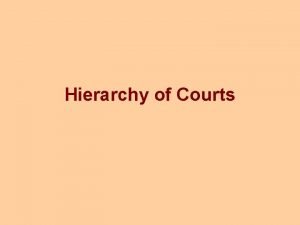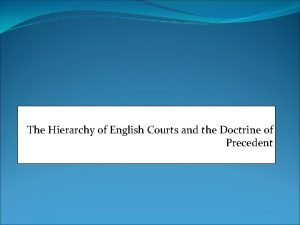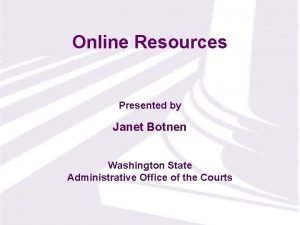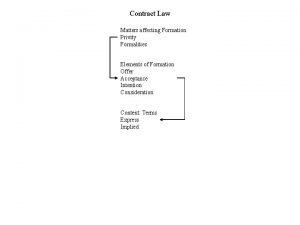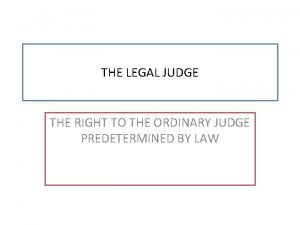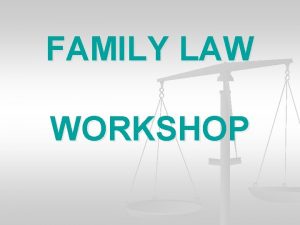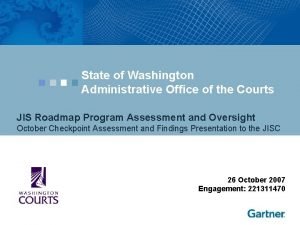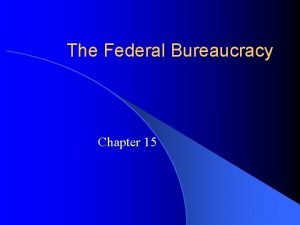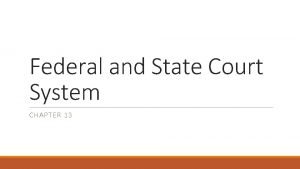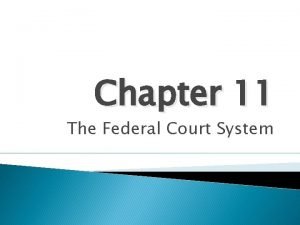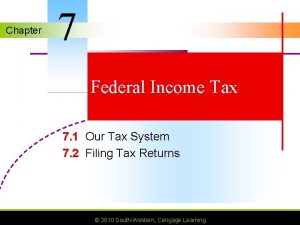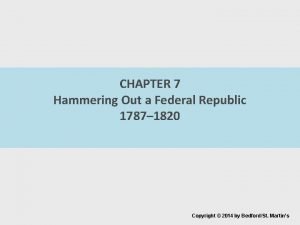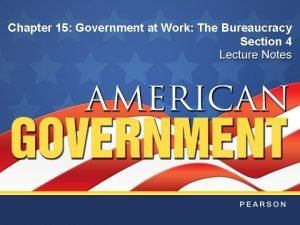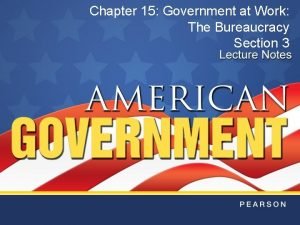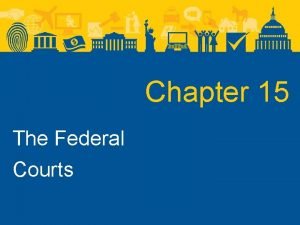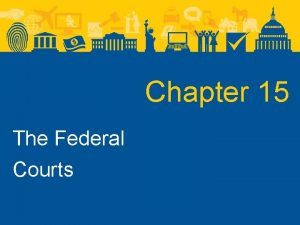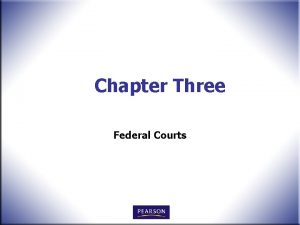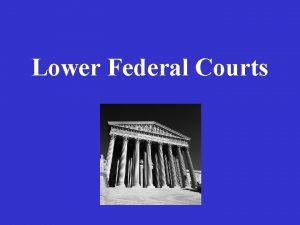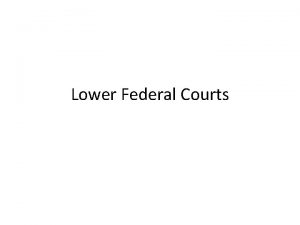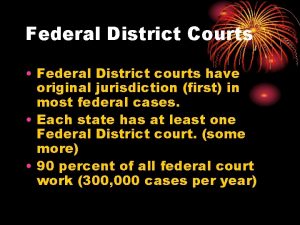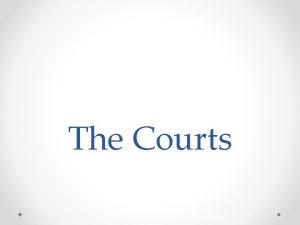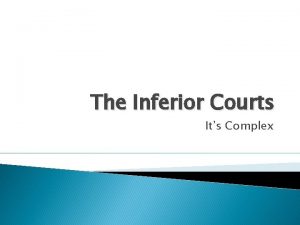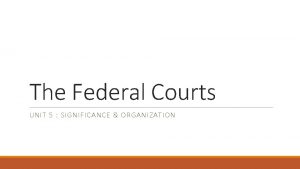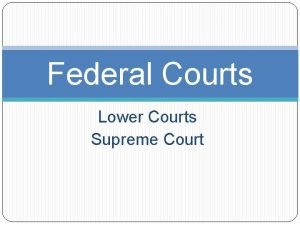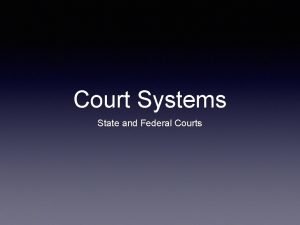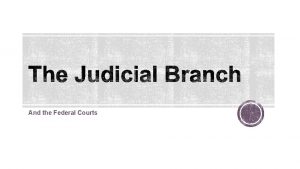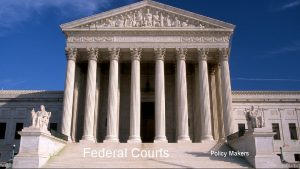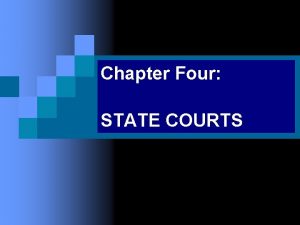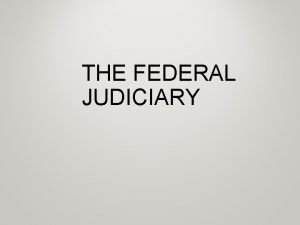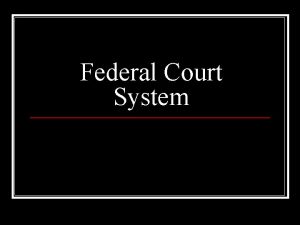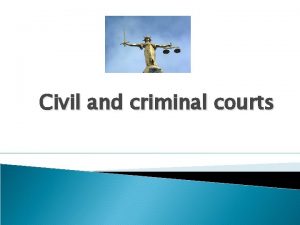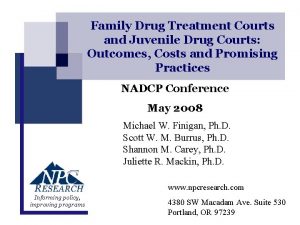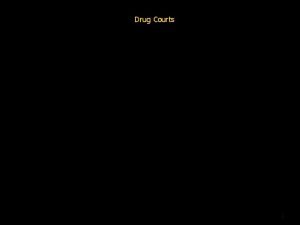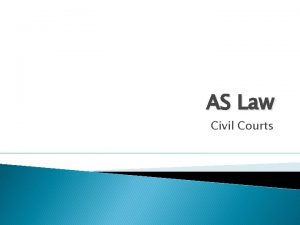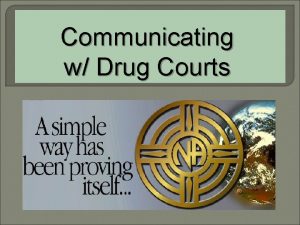Chapter 11 The Federal Courts The Federal Courts















































- Slides: 47

Chapter 11 The Federal Courts

The Federal Courts

The Legal System • “A government of laws and not of men. ” – John Adams, describing the new Massachusetts state constitution • Rule of law: all are equal before the law and none are immune from it. – Fundamental fairness expectation Americans have of the judicial system • “That’s not fair” is a tacit reference to rule of law.

The Legal System • Criminal law: the branch of law that regulates the conduct of individuals, defines crimes, and specifies punishments for criminal acts. – – Government is always the plaintiff. Defendant cannot be forced to testify. Standard: guilty beyond a reasonable doubt Penalties: fines, public service, imprisonment, death

Court Cases Proceed Under Criminal and Civil Law

The Legal System • Civil law: the branch of law that deals with disputes that do not involve criminal penalties. – – Plaintiff is the party that has been legally wronged. Defendant can be forced to testify. Standard: preponderance of evidence Penalties: typically monetary

The Legal System • Precedent: previous decisions from prior cases that are used to understand how a law is applied • Stare Decisis: “let the decision stand” – The use of precedent in a current case – The court is hesitant to overturn precedent

Types of Courts • State vs. federal • Trial vs. appellate • State Supreme Court

Types of Courts

Types of Courts • State vs. federal courts – Depends on the law in question • Federal law Federal court • State law State court • State cases can be appealed into the federal system if there has been a violation of the U. S. Constitution.

Types of Courts • Trial vs. appellate – Trial courts apply law to the facts of a given case. • Facts of the case are introduced • Judges and juries make sense of how facts relate to law. • Trial cases take both law and precedent into account.

Types of Courts • Trial vs. appellate – Appellate courts examine whether the law has been applied correctly in a trial court case. • New facts cannot be introduced. • If new facts are available, the case goes back to a trial court. • Appeals courts hear fewer cases than trial courts. – Typically dwell on complicated elements – Sole concern: whether laws applied correctly

Types of Courts • Supreme Court – The court of last resort – Has final interpretation over the Constitution and statutory law, be it state or federal – No state constitution can run contrary to the federal constitution – Recall, the Supreme Court is an appellate court. • No new facts allowed

The Supreme Court

Types of Courts • Due process of law – The right of every citizen against arbitrary action by national or state governments – A prisoner can appeal to a federal court if the state did not provide due process. • Habeas corpus – A prisoner can request a writ of habeas corpus, claiming a violation of rights.

Federal Jurisdiction • In 2008: – Federal district courts heard 349, 969 cases. – Federal courts of appeal heard 61, 104 cases. – U. S. Supreme Court heard 83 cases in 2008– 2009 term.

Types of Courts • Jurisdiction: where court has authority, power • Federal court domain includes: – – Cases between states Ambassadors Federal law U. S. Constitution • State and local courts have no say in the above listed kinds of cases.

Federal Trial Courts • Original jurisdiction: the ability to hear a case for the first time • Appellate jurisdiction: the power to hear appeals from a lower court

Federal Appellate Courts • 89 courts in 50 states, +1 Puerto Rico, +1 DC, three territories – Staffed by 679 judges – Almost always one judge per case • All areas of the United States and its territories are covered by one of 12 circuit courts.

Federal Appellate Courts • All areas of the Unites States and its territories are covered by one of 12 circuit courts. – Each court has six to 28 judges. – Each trial usually has three judges. – Sometimes the entire court can hear a case en banc.

Geographic Boundaries of United States Courts of Appeals

The U. S. Supreme Court • Nine justices – Chief justice and eight associate justices • System of equals, which functions on seniority basis • All judges have equal say, and each has one vote. • If chief justice sides with the majority opinion, he assigns the writing of the majority opinion. • If chief sides with the minority opinion, the most senior justice in the majority does.

The U. S. Supreme Court

How Judges are Appointed • Senatorial courtesy – Senators from the president’s party suggest nominees for district courts in their state when an opening appears. – President chooses from the list, then the Senate confirms. – The confirmation process has become highly political in recent decades.

Judicial Review • Judicial review: the power of the courts to review and, if necessary, declare actions of the legislative and executive branches invalid or unconstitutional. • The U. S. Constitution does not mention judicial review. – Marbury v. Madison (1803)

Judicial Review of Acts of Congress • Supremacy clause and Judicial Act of 1789 – All state laws and actions must be in conformity with the U. S. Constitution, federal laws, and treaties.

Judicial Review Also Applies to State Actions

U. S. Supreme Court Cases • U. S. Supreme Court has original jurisdiction in cases concerning: – – Disputes between states Ambassadors Federal law U. S. Constitution

Cases Filed in the U. S. Supreme Court, 1938– 2007 Terms

Writ of Certiorari • The SCOTUS is more likely to “grant cert” to cases where: – An important civil right or civil liberty is at stake – Appellate courts have ruled differently on the same law, and it needs to be applied universally. – A lower court has ruled differently from precedents established by a higher court. – The federal government is filing the appeal.

Solicitor General • Federal government’s top lawyer – All cases before the Supreme Court are argued by an attorney from the solicitor general’s office, often by the solicitor general himself or herself. – When the solicitor general requests a writ of certiorari, the justices take the request extremely seriously.

How Cases Reach the Supreme Court

Amicus Curiae • Amicus briefs can be filed by any stakeholder in a case, even if that person is not directly involved in the litigation. – Useful sources of legal interpretation and facts

Lobbying for Access • Some interest groups have long-term legal strategies. – Bring test cases under the most favorable circumstances – Bring cases in specific circuits expecting the appeals court to side a certain way – Have access to top experts in the field

The Supreme Court’s Procedures

The Supreme Court’s Procedures • Preparation – Both sides submit briefs, as do other interested parties. – The attorneys will also prepare extensively for the questions they may face. – By the time a case reaches the Supreme Court, the original attorneys may be replaced by more experienced attorneys.

The Supreme Court’s Procedures • Oral argument – The Court meets three times per week when in session. – Each side gets a half hour, with many interruptions. – Sometimes, several different attorneys will address different aspects of the argument.

The Supreme Court’s Procedures • The conference – Justices meet by themselves on Wednesdays and Fridays when in session. – Hold an initial vote – Chief justice or most senior justice will assign a justice to write the majority opinion. – Usually, the dissenting opinion is assigned as well. – Most opinions are written by the clerks under the supervision of the justice.

The Supreme Court’s Procedures

Activism and Ideology • Activism versus restraint – Judicial restraint: the Court should look only at the words of the Constitution when interpreting it. • “Strict constructionists” – Judicial activism: the Court should consider the broader societal implications of its decisions as well as the words of the Constitution.

Purpose of the Courts • Framers of the Constitution created courts to protect individuals from the potential “tyranny of the majority. ” • Today, courts are also used to create and promote social policies (i. e. , abortion, workers’ rights).

Public Opinion Poll Do you think federal judges should be appointed for life terms, limited terms, or elected? a) Federal judges should be appointed for life. b) They should have limited appointment terms. c) Federal judges should be elected.

Public Opinion Poll Do you believe the decisions of the federal courts are primarily driven by legal doctrine or individual judge’s political ideology? a) Legal doctrine b) Political ideology

Public Opinion Poll Do you believe members of the U. S. Senate should have the ability to block judicial nominations based solely on the nominee’s political ideology and party? a) Yes b) No

Public Opinion Poll Do you believe the U. S. Supreme Court should televise or online stream their proceedings? a) Yes b) No

Public Opinion Poll Compared to the presidency and the Congress, do you think the Court has too little, too much, or the right amount of influence on American policy and law? a) Too little influence b) Too much influence c) About the right amount

Chapter 12: The Federal Courts • Quizzes • Flashcards • Outlines • Exercises wwnorton. com/we-the-people
 Chapter 18 section 4 the special courts
Chapter 18 section 4 the special courts Section 2 guided reading and review the inferior courts
Section 2 guided reading and review the inferior courts Hierarchy of courts uk
Hierarchy of courts uk Courts hierarchy
Courts hierarchy Doctrine of precedent
Doctrine of precedent Tennis courts wolverhampton
Tennis courts wolverhampton Judiciary system in india
Judiciary system in india Precedent in court
Precedent in court 4 levels of state courts
4 levels of state courts Fare program arizona state courts
Fare program arizona state courts Specialisation court hierarchy
Specialisation court hierarchy New jersey courts
New jersey courts Judicial branch clip art
Judicial branch clip art Jurisdiction of supreme court
Jurisdiction of supreme court Hierarchy of english courts
Hierarchy of english courts Inside courts wa
Inside courts wa When will the courts imply terms into a contract
When will the courts imply terms into a contract The indolent judge
The indolent judge Oh romeo my romeo
Oh romeo my romeo Maryland court hierarchy
Maryland court hierarchy Family law facilitator
Family law facilitator Washington administrative office of the courts
Washington administrative office of the courts Chapter 15 the federal bureaucracy
Chapter 15 the federal bureaucracy Chapter 13 federal and state court systems
Chapter 13 federal and state court systems The federal court system chapter 11 answer key
The federal court system chapter 11 answer key Chapter 7 federal income tax
Chapter 7 federal income tax Apush chapter 7 hammering out a federal republic
Apush chapter 7 hammering out a federal republic Which trend characterized thomas jefferson's presidency?
Which trend characterized thomas jefferson's presidency? Chapter 15 section 1 the federal bureaucracy answer key
Chapter 15 section 1 the federal bureaucracy answer key Chapter 15 section 1 the federal bureaucracy
Chapter 15 section 1 the federal bureaucracy Hình ảnh bộ gõ cơ thể búng tay
Hình ảnh bộ gõ cơ thể búng tay Slidetodoc
Slidetodoc Bổ thể
Bổ thể Tỉ lệ cơ thể trẻ em
Tỉ lệ cơ thể trẻ em Gấu đi như thế nào
Gấu đi như thế nào Tư thế worm breton là gì
Tư thế worm breton là gì Chúa sống lại
Chúa sống lại Kể tên các môn thể thao
Kể tên các môn thể thao Thế nào là hệ số cao nhất
Thế nào là hệ số cao nhất Các châu lục và đại dương trên thế giới
Các châu lục và đại dương trên thế giới Công của trọng lực
Công của trọng lực Trời xanh đây là của chúng ta thể thơ
Trời xanh đây là của chúng ta thể thơ Mật thư tọa độ 5x5
Mật thư tọa độ 5x5 Làm thế nào để 102-1=99
Làm thế nào để 102-1=99 độ dài liên kết
độ dài liên kết Các châu lục và đại dương trên thế giới
Các châu lục và đại dương trên thế giới Thể thơ truyền thống
Thể thơ truyền thống Quá trình desamine hóa có thể tạo ra
Quá trình desamine hóa có thể tạo ra
